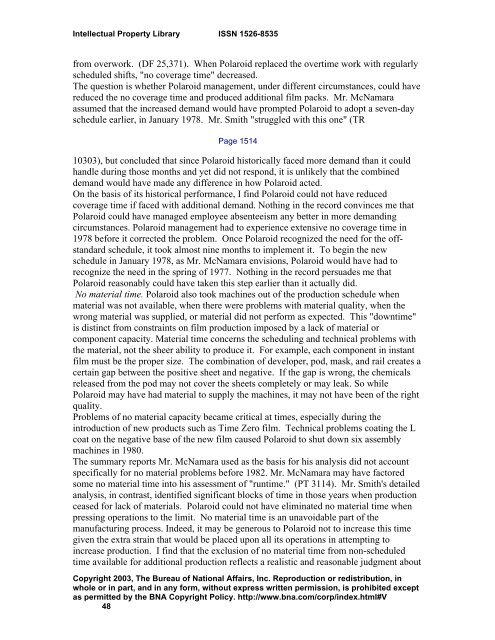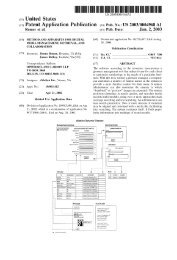Polaroid Corp. v. Eastman Kodak Co. - Oppedahl Patent Law Firm LLC
Polaroid Corp. v. Eastman Kodak Co. - Oppedahl Patent Law Firm LLC
Polaroid Corp. v. Eastman Kodak Co. - Oppedahl Patent Law Firm LLC
You also want an ePaper? Increase the reach of your titles
YUMPU automatically turns print PDFs into web optimized ePapers that Google loves.
Intellectual Property Library ISSN 1526-8535<br />
from overwork. (DF 25,371). When <strong>Polaroid</strong> replaced the overtime work with regularly<br />
scheduled shifts, "no coverage time" decreased.<br />
The question is whether <strong>Polaroid</strong> management, under different circumstances, could have<br />
reduced the no coverage time and produced additional film packs. Mr. McNamara<br />
assumed that the increased demand would have prompted <strong>Polaroid</strong> to adopt a seven-day<br />
schedule earlier, in January 1978. Mr. Smith "struggled with this one" (TR<br />
Page 1514<br />
10303), but concluded that since <strong>Polaroid</strong> historically faced more demand than it could<br />
handle during those months and yet did not respond, it is unlikely that the combined<br />
demand would have made any difference in how <strong>Polaroid</strong> acted.<br />
On the basis of its historical performance, I find <strong>Polaroid</strong> could not have reduced<br />
coverage time if faced with additional demand. Nothing in the record convinces me that<br />
<strong>Polaroid</strong> could have managed employee absenteeism any better in more demanding<br />
circumstances. <strong>Polaroid</strong> management had to experience extensive no coverage time in<br />
1978 before it corrected the problem. Once <strong>Polaroid</strong> recognized the need for the offstandard<br />
schedule, it took almost nine months to implement it. To begin the new<br />
schedule in January 1978, as Mr. McNamara envisions, <strong>Polaroid</strong> would have had to<br />
recognize the need in the spring of 1977. Nothing in the record persuades me that<br />
<strong>Polaroid</strong> reasonably could have taken this step earlier than it actually did.<br />
No material time. <strong>Polaroid</strong> also took machines out of the production schedule when<br />
material was not available, when there were problems with material quality, when the<br />
wrong material was supplied, or material did not perform as expected. This "downtime"<br />
is distinct from constraints on film production imposed by a lack of material or<br />
component capacity. Material time concerns the scheduling and technical problems with<br />
the material, not the sheer ability to produce it. For example, each component in instant<br />
film must be the proper size. The combination of developer, pod, mask, and rail creates a<br />
certain gap between the positive sheet and negative. If the gap is wrong, the chemicals<br />
released from the pod may not cover the sheets completely or may leak. So while<br />
<strong>Polaroid</strong> may have had material to supply the machines, it may not have been of the right<br />
quality.<br />
Problems of no material capacity became critical at times, especially during the<br />
introduction of new products such as Time Zero film. Technical problems coating the L<br />
coat on the negative base of the new film caused <strong>Polaroid</strong> to shut down six assembly<br />
machines in 1980.<br />
The summary reports Mr. McNamara used as the basis for his analysis did not account<br />
specifically for no material problems before 1982. Mr. McNamara may have factored<br />
some no material time into his assessment of "runtime." (PT 3114). Mr. Smith's detailed<br />
analysis, in contrast, identified significant blocks of time in those years when production<br />
ceased for lack of materials. <strong>Polaroid</strong> could not have eliminated no material time when<br />
pressing operations to the limit. No material time is an unavoidable part of the<br />
manufacturing process. Indeed, it may be generous to <strong>Polaroid</strong> not to increase this time<br />
given the extra strain that would be placed upon all its operations in attempting to<br />
increase production. I find that the exclusion of no material time from non-scheduled<br />
time available for additional production reflects a realistic and reasonable judgment about<br />
<strong>Co</strong>pyright 2003, The Bureau of National Affairs, Inc. Reproduction or redistribution, in<br />
whole or in part, and in any form, without express written permission, is prohibited except<br />
as permitted by the BNA <strong>Co</strong>pyright Policy. http://www.bna.com/corp/index.html#V<br />
48





